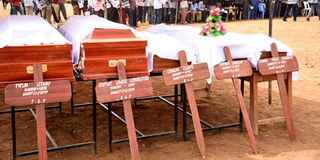Premium
Towns stalked by death every day

Caskets with bodies of people, including three schoolboys, killed in an attack by livestock-stealing bandits in Baringo South. CHEBOITE KIGEN | NATION
Before 1997, Todonyang, on the shores of Lake Turkana and near the border between Kenya and Ethiopia, was a thriving town.
It had a primary school with hundreds of pupils, a chief’s office, a fisherfolk’s cooperative society and a dispensary.
Then there was a dispute between two communities: the Merille from Ethiopia and the Turkana. The row has never been resolved.
In May 2011, Merille rustlers raided the centre, killed at least 50 people and took away all the animals.
Since then, hundreds of people have been killed in Todonyang.
The local Catholic mission has fenced off an area housing more than 200 graves, mostly of women and children.
“Due to the atrocities and in remembrance of victims, the local parish was christened Our Lady Queen of Peace,” Fr Alex Capon, the priest who heads the Catholic Mission in Lobur Kaikor, said.
Despite the name change, Todonyang has not experienced peace, security and stability since.
While marking 10 years of the Todonyang Catholic mission in 2016, which was also the first public meeting to try and unite the two communities, a Turkana herder shot a Merille elder, leading to pandemonium.
“What used to be a vibrant village of fishermen is now ghostly. This is the cost of unending raids,” Fr Capon said.
KILLED CHIEF
In July 2018, Merille raiders shot and killed Todonyang chief Ekal Lochamin. They also stole a number of cattle.
Without peace and security, Todonyang is on the growing list of towns, market centres and villages in pastoralist regions that have been left to rot following endless raids.
Failure to find a permanent solution to a century-long arms race between communities in northern Kenya continues to leave a trail of blood and tears.
The eight counties in the north make up 36 per cent of Kenya’s land mass.
According to the Inter-Governmental Authority for Development Centre for Pastoral Areas and Livestock Development, more than half of Kenya, or 27 counties, experiences some form of cattle rustling categorised as moderate, mild or severe.
Turkana, Marsabit, Samburu, Isiolo, Laikipia, Baringo, Elgeyo-Marakwet and West Pokot are, according to many studies, the worst hit, with their economies losing Sh14.1 billion annually in the form of stolen animals and cost of displacement.
Beneath these worrying economic numbers are scary tales of death and towns that have ground to a halt or whose economies are limping as government security agencies continue to call press conferences in Nairobi about the need to find a permanent solution to the problem.
Other towns that have been turned into shells of their former selves are Tot in Elgeyo-Marakwet, Chesegon on the Elgeyo-Marakwet and Baringo border and Kapindasum, Loruk, Mukutani, Kinyach, Amiyan and Kapedo in Baringo
Baragoi is a graveyard
Tot is conveniently in the lush Elgeyo-Marakwet hills where fruits grow all year round.
The land is rich and the people prosperous. Yet, even in this paradise, violence remains a threat.
Tot is, unfortunately, on a route favoured by rustlers heading to Kerio Valley.
The town can go for days without electricity. Its fruit market died a long time ago and only one school operates.
In Baragoi, residents hold at least a funeral for a bandit victim every week. The public cemetery is full but more bodies keep arriving.
“Baragoi is a graveyard. We are Kenyans but why is the law being applied selectively?” Samburu Deputy Governor Julius Leseto asked recently.
In the eight counties we traversed in the course of our investigations, the story is the same.
Everyone is crying for attention from the government but the answers hardly seem to be forthcoming.






